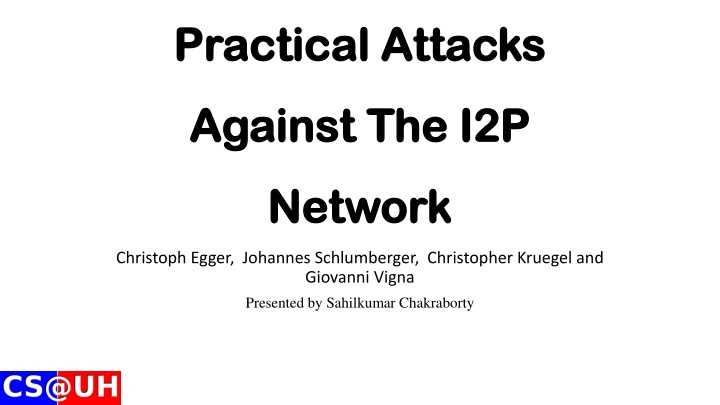
Practical Attacks Against the I2P Network: Overview and Design Details
"Explore practical attacks against the I2P network and its design, including connectivity, database structure, and defense mechanisms. Learn about the decentralized and secure nature of the Invisible Internet Project. Understand how attacks aim to expose peers using specific services within the network."
Download Presentation

Please find below an Image/Link to download the presentation.
The content on the website is provided AS IS for your information and personal use only. It may not be sold, licensed, or shared on other websites without obtaining consent from the author. If you encounter any issues during the download, it is possible that the publisher has removed the file from their server.
You are allowed to download the files provided on this website for personal or commercial use, subject to the condition that they are used lawfully. All files are the property of their respective owners.
The content on the website is provided AS IS for your information and personal use only. It may not be sold, licensed, or shared on other websites without obtaining consent from the author.
E N D
Presentation Transcript
Practical Attacks Practical Attacks Against The I2P Against The I2P Network Network Christoph Egger, Johannes Schlumberger, Christopher Kruegel and Giovanni Vigna Presented by Sahilkumar Chakraborty
Overview I2P Design Types Of Attacks Evaluation and Discussions
I2P Design The Invisible Internet Project (I2P) is an overlay network and darknet that allows applications to send messages to each other pseudonymously and securely. I2P is a project to build, deploy, and maintain a network supporting secure and anonymous communication. There is no central point in the network on which pressure can be exerted to compromise the integrity, security, or anonymity of the system. The network supports dynamic reconfiguration in response to various attacks, and has been designed to make use of additional resources as they become available.
I2P Design Connectivity between applications is implemented via a fully decentralized peer-to-peer network, which runs as an overlay on top of IP. I2P stores all metadata in a distributed hash table (DHT), which is called netDB. The DHT ensures scalability of the network. TCP-like protocol called NTCP . UDP-like protocol called SSU. Tunnels are identified by the outermost peer in the chain and a unique tunnelID.
I2P Design How does I2P work?
I2P Design Router Info and Lease Set The netDB keeps two types of records: Peer information or routerInfo Service information or leaseSets
I2P Design Network Database Database records are stored in a Kademlia-style DHT [10] with some modifications to harden it against attacks. This modified database is called floodfill database The participating nodes floodfill nodes. The number of floodfill nodes is limited to only few well- connected members
I2P Design Network Database Floodfill participation is designed to regulate the number of floodfill nodes in the network and keep them at a constant count. There are two kinds of database servers, Manual floodfill participants Automatic floodfill participants
Defining the Attacks The final goal of the attacks is to identify peers using a particular service on I2P and their individual usage patterns, including when and for how long they use this service. The paper describes different ways to gain the necessary control on the netDB and include a brief discussion of how to perform a classical Eclipse attack where access to a service inside the I2P network is blocked by the attacker.
Types of Attack 1. Floodfill Takeover By taking control of the netDB, one can log database actions for the full keyspace. The attack is possible with relatively few resources (only 2 % of total nodes in the network are needed). The attacker can configure his nodes as manual floodfill nodes to make sure his nodes participate in the database. Around 95 % of the floodfill nodes are automatic, that is, While there will not be the need for more participants once the attacker has set up his nodes, all current participants continue to serve as floodfill.
Types of Attack As load varies and routers tend to be rebooted from time to time, the least noisy and easy-to-deploy possibility is waiting for the number of legitimate floodfill participants to decrease while the attacker adds malicious nodes to the network. This is especially effective every time an update to the I2P software is distributed, as updating I2P includes a restart of the router.
Types of Attack However, to speed up churn in the floodfill set, an attacker can influence the job lag using a denial-of-service (DoS) attack against a legitimate floodfill participant. The attacker creates many new tunnels through the attacked node adding a tunnel build job for each. If the attacker is able to create more open jobs than the node can handle, these jobs get started late, building up a job lag.
Types of Attack 2. Sybil Attack Well-known attack where a malicious user creates multiple identities to increase control over the system. It is possible to control more identities in the network by running multipleI2P instances on the same hardware. However, participants evaluate the performance of peers they know of and weight them when selecting peers to interact with instead of using a random sample. As running multiple identities on the same host decreases the performance of each of those instances, the number of additional identities running in parallel is effectively limited by the need to provide each of them with enough resources for being considered as peers.
Types of Attack A Sybil attack will allow the attacker to get close control over a limited part of the keyspace, and it requires fewer resources than the complete takeover. While an attacker cannot run (too many) I2P nodes in parallel due to the peer profiling that is in place, it is possible to compute huge quantities of identities offline and then use the best placed ones (the ones closest to the victim in the keyspace). To exhaust the query limit with negative responses, a total of eight nodes near the target key are necessary (over here near means closer than any legitimate participant in this region of the netDB).
Types of Attack Introducing a new node into the network requires a setup time of about an hour, during which the node gets known by more and more of its peers and actively used by them for lookup. Thus, it takes some time until the Sybil attack reaches the maximal impact. In addition, the storage location of the keys that the attacker is interested in changes every day at midnight. This requires attacking nodes to change their location in the keyspace, opening a window during which legitimate nodes control the position in question. However, as the rotation is known in advance, a second set of attack nodes can be placed at the right spot before midnight, so they are already integrated once the keyspace shifts. As a result, this keyspace rotation does not prevent our attack but only requires few additional resources.
Types of Attack 3. Eclipse Attack With a vanilla Kademlia DHT, all requests would be answered by the node nearest to the searched key. If this node is malicious and claims not to know the key and not to know any other database server nearer to the key, the lookup will fail. To circumvent this attack, I2P stores the key on the eight nodes closest to the key and a requesting node will continue asking nodes further away from the key if they no longer know any candidate nearer to the searched key.
Types of Attack Our Eclipse attack allows an attacker to make any database record unavailable to network participants. As clients use up to eight floodfill nodes to locate a key in the network database, the attacker needs to control at least the eight nodes closest to the key.
Types of Attack 4. Deanonymization of Users For this attack,the Sybil attack is used which is described earlier to place malicious nodes in the netDB so they can observe events in the network related to each other. Later information from these events is used to deanonymize users. Nodes store their database records on the closest floodfill node that they are aware of. To verify proper storage of a database record, a node subsequently sends a lookup to another floodfill node nearby. This is done after waiting for 20 seconds. If both nodes, the one stored on and the one handling the verifying lookup, are controlled by the same (malicious) entity, the attacker can observe both interactions and connect them.
Types of Attack Storage of peer information is done without a tunnel. That is, it is done in the clear, as the client is exposed by the content of the database entry anyways. Storage verification, on the other hand, is done through an exploratory tunnels to make it more difficult to distinguish storage verification from normal lookup (if floodfill nodes could distinguish verifications from normal lookups, they could allow verification and still hide the stored information from normal lookups). As a result, the first part of this interaction exposes the client node, while the second part exposes an exploratory tunnel endpoint. This combination allows us to create a probabilistic mapping between exploratory tunnel endpoints and the peers owning the tunnel.
Types of Attack The attack process is shown in figure : The client (victim) stores its peer information on Node 7 in the netDB. This node then pushes the peer information to other floodfill nodes that are close in the netDB. In this case, these close nodes are Node 6, Node 8 and Node 9. After 20 seconds, the client starts the verification process and requests its own peer information from Node 6, using one of its exploratory tunnel pairs. Later, it requests the service information for an eepsite from Node 4, using the same exploratory tunnel. If the attacker controls Nodes 4, 6 and 7, he can (i) leverage the store and verification operation (on Node 6 and 7) to map the victim s tunnel identifier to the actual victim node, and (ii) see the victim requesting the service (on Node 4).
Evaluation Floodfill Takeover The paper discusses the impact of a takeover attack and the time needed for a passive takeover where the attacker only waits for automatic floodfill nodes to resign due to normal fluctuations in the network. The fraction of automatic floodfill nodes in the network was determined by monitoring the local peer storage on the routers under our control. These routers participated as floodfill nodes in the real I2P network, and logged whenever a node removed or added the floodfill flag to its peer information.
Evaluation Floodfill Takeover
Evaluation Experimental Setup The authors ran 20 attacking nodes connected to the normal I2P network. These nodes acted as floodfill peers. Six additional nodes served as legitimate peers, and were used to verify the attacks. All attackers were set up on a single VM host in the US and configured to use 128kB/s of download and 64kB/s of upload data rate. The legitimate nodes were split evenly between the VM host in the US and a second VM host in Europe (to make sure the results do not rely on proximity between attackers and victims). Attackers were configured to act as manual floodfill nodes and had additional code added, which logged network events and allowed for the blacklisting of specific information, as required by the Eclipse attack. During our experiments, the I2P statistics reported between 18,000 and 28,000 nodes and 320 to 350 floodfill nodes, fluctuations during the day.
Evaluation Experimental Setup (Sybil Attack) The authors created a set of 50,000 precomputed router identities. Each identity consists of one signing and one encryption key (as well as a certificate, which is unused). Computing this set of identities took less than 30 minutes on a twelve- core Xeon server. Also they modified the router software to enable their attacking nodes to change their identity to any of the precomputed ones on demand, as well as to enable a group of attackers to use a set of identities, one per node, close to a target.
Evaluation Experimental Setup (Eclipse Attack) The authors configured their victims to download a test eepsite every minute, and log the results. Ten attack nodes were moved to the storage location of the service information for the test eepsite. The attackers were configured to give negative response to all lookups for the test eepsite and only refer to each other in these negative responses such that the victims would learn about all malicious floodfill nodes as fast as possible. A second group of ten attack nodes was moved to the test eepsite s storage location for the following day, and was configured to keep the service information unavailable across the keyspace shift.
Evaluation Experimental Setup (Eclipse Attack) They ran the setup for 42 hours. During which Victims were on average able to reach the blocked eepsite for a total of five minutes. Three out of six nodes were not able to reach the eepsite at any point in time The most successful victim was able to interact with the destination for a total of only 16 minutes during that period
Evaluation Experimental Setup (Deanonymization of Users) For the simulated attack, the authors first configured ten malicious nodes and set them up as floodfill nodes in the keyspace region occupied by our six victim nodes. Then they configured six victim nodes to repeatedly query our test eepsite.
Evaluation Experimental Setup (Deanonymization of Users) Next the authors tried to understand how many lookups observed at the malicious nodes could be properly attributed to the queries made by the victims. Observing lookups doesn t answer the question. It is also necessary to attribute different lookups (and tunnel endpoints) to the victim machines. Other wise,it cannot determined whether a victim has requested a particular service. Since the network is not only used by the victims, the malicious nodes receiveunrelated lookups by other (random) nodes in the I2P network.
Evaluation Experimental Setup (Deanonymization of Users) Next the authors tried to understand how many lookups observed at the malicious nodes could be properly attributed to the queries made by the victims. Observing lookups doesn t answer the question. It is also necessary to attribute different lookups (and tunnel endpoints) to the victim machines. Otherwise, it cannot determined whether a victim has requested a particular service. Since the network is not only used by the victims, the malicious nodes receiveunrelated lookups by other (random) nodes in the I2P network. 52% of the time they matched up to Alice and but considering that this was only for a specific resource if the access to other resource are also monitered over a longer period of time allows to mount a much stronger attack.
Discussion Limitations (Deanonymization of Users) For a successful deanonymization of a client s lookups, the attacker needs to have his floodfill nodes both next to the client s peer info storage position and the service information s storage position in the netDB. Therefore, a Sybil attack requires the attacker to limit himself to a small number of services and peers. However, as there are just three malicious floodfill nodes required for each monitored service, and the number of darknet services interesting to the attacker is likely to be small, tracking specific user is not a problem. As many clients map to the same region in the keyspace and, therefore, store their peer information to the same set of floodfill nodes, it is also possible to track all these users without additional resources. However, as the mapping to the keyspace is essentially random, the attacker cannot select an arbitrary group of clients, but only clients close together in the keyspace.
Discussion Potential Attack Improvements Instead of blocking lookups, an Eclipse attack could also block the store operation. An approach similar to the one used for the deanonymization attack can be used to make the storing node believe that the storage was successful, while it was actually blocked. More precisely, the attacking floodfill nodes can identify the victim s verification step, and only signal successful lookup for this verification, while replying with a negative response to all regular lookups.
Discussion Implemented Improvements The limit of floodfill nodes was raised from 300 to 500, requiring an attacker to run almost twice as many malicious nodes to take control over the full network database and reducing the fraction of the keyspace controlled by a single node Only one floodfill node per /16 subnet is considered now for database lookups, requiring an attacker to spread nodes over several networks in order to successfully execute an Eclipse attack.
Discussion Suggested Improvements To counter Sybil attacks, a client node could only start to trust a floodfill node after seeing it participate for n days in the network. This would increase the cost for multi-day attacks, as the attacker needs to have n +1 attack groups active at the same time. This adds a multi-day setup time during which his intentions could be discovered, and potential victims could be warned using the newsfeed of the I2P client software. To use direct connections for the verifying lookup
Conclusion In this paper were presented attacks that can be combined to deanonymize I2P users. This confirms that critical attacks (such as Sybil and Eclipse attacks) against DHTs used for anonymity systems are still valid, even when these systems are designed to resist these threats for practical purpose.
Thank you! Thank you! Questions?






















